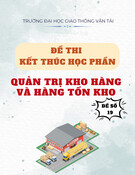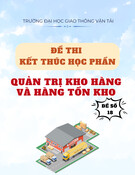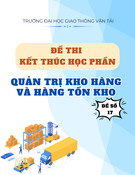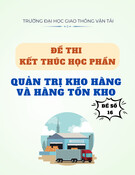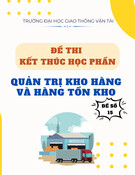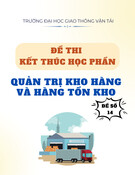
* Corresponding author
E-mail address:wahabhasyim@gmail.com (A. W. Hasyim)
© 2019 by the authors; licensee Growing Science, Canada
doi: 10.5267/j.uscm.2018.10.009
Uncertain Supply Chain Management 7 (2019) 157–168
Contents lists available at GrowingScience
Uncertain Supply Chain Management
homepage: www.GrowingScience.com/uscm
Does cost accounting system contributes in supply chain operations?
Abd. Wahab Hasyima* and Abdullah W. Jabidb
aFaculty Of Economics and Business, Khairun University Ternate, Indonesia
bFaculty Of Economics and Business, Khairun University Ternate, Indonesia
C H R O N I C L E A B S T R A C T
Article history:
Received September 12, 2018
Accepted October 24 2018
Available online
October 25 2018
Indonesian agriculture sector has a major contribution in the nation’s economy. However, due to
decrease in supply chain performance, the overall performance is declining which affect
negatively on Gross Domestic Product (GDP). The contribution of Indonesian agriculture sector
in GDP is declined to 84110 IDR Billion in the second quarter of 2018 from 84577.50 IDR
Billion in the first quarter of 2018. The supply chain is one of the responsible factors of this issue.
Therefore, to address this problem, the objective of the current study is to investigate the role of
cost accounting system (CAS) on supply chain operations by considering the internal and
external contingent factors. Moreover, the moderating role of legal obligations was also
examined. In rare cases, some studies formally documented the effect of CAS on supply chain
operations. Managerial employees of agricultural firms were selected to collect the necessary
data and 150 questionnaires were distributed among them. Results of PLS-SEM show that CAS
had a significant positive contribution in supply chain operations. Better implementation of CAS
in agriculture firms had the ability to boost the performance. Moreover, other factors such as
firm size, product diversity and competition also had a significant effect on CAS implementation.
In this survey, legal obligations moderated the relationship between firm size and CAS. Finally,
this study is beneficial for agriculture firms to enhance their performance by using better supply
chain strategies through CAS.
ensee Growing Science, Canada
b
y the authors; lic9© 201
Keywords:
Cost accounting system
Supply chain
Firm size
Product diversity
Legal obligations
Indonesian agriculture sector
1. Introduction
Cost accounting system (CAS) has received less consideration in the agriculture industry during the
past few years (Fatah, 2013). It is one of the systems, which provides a platform to survive in the
industry by reducing the cost and increasing profit margins (Ogundana et al., 2017). Various emerging
economics are facing issues in the implementation of CAS due to worldwide competition (Nze, et al.
2016; Biondi et al., 2017; Kimengsi & Gwan, 2017; Chowdhury, et al. 2018), particularly Indonesia
is facing the issue to implement CAS in the agriculture industry. Due to the improper implementation
of CAS the supply chain activities are not working efficiently, and the overall performance of
Indonesian agriculture sector is decreasing day by day. As the supply chain has a significant role in
every industry (Castorena, et al. 2014; Dim & Ezeabasili, 2015; Wang & Lu, 2016; Hameed et al.,

158
2018; Hameed et al., 2018). The agriculture sector is most significant to cope economic crises (
Purnama, 2014; Ahmad, et al. 2016; Nazal, 2017; Girik Allo et al., 2017; Taqi et al., 2018). However,
the performance of Indonesian agriculture sector is declining. Indonesian agriculture sector has a major
contribution in nations economy (Yunus, 2017), however, due to decrease in supply chain performance,
the overall contribution is declining which effect negatively on gross-domestic-product (GDP). It is
also mentioned by Zaki (2004) that the performance of agriculture is decreasing. Therefore, Indonesia
must spend in agriculture R & D. However, as it is shown in Fig. 1, the contribution of agriculture
spending of Indonesia is below than other countries.
Fig. 1. Indonesia Agriculture Share to GDP Fig. 2. Recent Indonesian GDP from Agriculture
Source: Agriculture Science and Technology Indicators (ASTI) database, World Bank staff calculations,
STATISTICS INDONESIA (2018) TRADINGECONOMICS.COM
Moreover, Indonesian agriculture share in GDP is below the industry. According to Zaki (2004),
agriculture sector is contributing less as compared with the industry and service sector. However, if we
review the most recent performance of Indonesian agriculture sector, then we come up with the results
that its performance is not consistent and sudden ups and downs, which create the uncertainty in GDP
contribution. Fig. 3 shows the agriculture sector contribution in GDP from 2015 to the last quarter of
2018. GDP from Agriculture in Indonesia declined to 84110 IDR Billion in the second quarter of 2018
from 84577.50 IDR Billion in the first quarter of 2018. GDP contribution from Indonesian Agriculture
has averaged 68616.26 IDR Billion approximately from 2010 to 2018 and attained maximum growth
of 88067.70 IDR Billion in the first quarter of the year 2017, shown in Fig. 2 and a record low of
37282.50 IDR Billion in the fourth quarter of 2012. However, these issues can be resolved through
better supply chain management activities with the help of proper implementation of CAS. Higher
performance in 2017 can be traced back through better CAS system and supply chain effectiveness.
Therefore, the main research question is: What is the contribution of CAS and supply chain operation
to boost the performance of Indonesian agriculture sector? In this process, various internal and external
contingent factors also effect on agriculture supply chain operations through CAS. Prior studies have
tried to relate the use of CASs to many contextual variables categorized into external as well as internal
variables (Haldma & Lääts, 2002).
Most important internal factors include; firm size and product diversity, however, external factors
include; the intensity of competition (Abdel-Kader & Luther, 2008; Al-Omiri & Drury, 2007). Apart
from external and internal factors, another factor namely; legal obligations also impacts on CAS
practices (Argilés & Slof, 2003) which has an influence on supply chain activities. Legal obligations
are based on government rules and regulations. Therefore, the objective of the current study is to
investigate the role of CAS on supply chain operations by considering the internal and external
contingent factors. Moreover, the sub-objectives of the current study are as follows;
0.4 0.35 0.25
0.5
0.2 0.3
1.5
2.9
0
0.5
1
1.5
2
2.5
3
3.5
78572.8
40026.9
77985.3
45976.1
79953.9
43801.3
84110
0
10000
20000
30000
40000
50000
60000
70000
80000
90000
Jul-15
Oct-15
Jan-16
Apr-16
Jul-16
Oct-16
Jan-17
Apr-17
Jul-17
Oct-17
Jan-18
Apr-18
Jul-18
IDR Billion

A. W. Hasyim and A. W. Jabid / Uncertain Supply Chain Management 7 (2019)
159
1. To identify the role of contingent external factors in CAS,
2. To identify the role of contingent internal factors in CAS,
3. To identify the role of CAS in effective management of supply chain operations,
4. To identify the moderating role of legal obligations.
Fig. 3. Theoretical Framework showing that how CAS contribute to supply chain operations
2. Literature Review
CAS is the most suitable to enhance supply chain operations, particularly in agriculture firms. To settle
on different choices in the business environment, cost information is required. Cost accounting systems
give suitable cost information that helps with settling on the correct choice or picking the most
profitable choice from the accessible options. Zaki (2004) expressed that cost accounting gives valuable
cost information to agricultural firms identified with helping them to make examinations between the
costs and profits and to utilize these estimations according to the plans. Agricultural firms can utilize
cost information to set items' costs and decide the cost of each item independently; likewise, cost
information is utilized to get ready financial statements accurately. Cost accounting systems are
administrative instruments that expect to accomplish certain destinations, for example, supply chain
operations, giving cost information to basic leadership, cost control, and deciding item costs. CASs can
create vital information for leaders, aid the planning of financial reports, and help the senior
administration in any business association to complete its capacities (Wijewardena & De Zoysa, 1999;
Haldma & Lääts, 2002; Szychta, 2002; Solomon et al. 2014; Jaya & Verawaty 2015; Angbre, 2016;
Tanoos, 2017; Adusei, 2018).
The Institute of Cost and Works Accountants (ICWA) defined CAS as “the process of accounting for
cost from the point at which expenditure is incurred to the establishment of its ultimate relationship
with cost centers and cost units. In its widest usage, it embraces the preparation of statistical data, the
application of cost control methods and the ascertainment of the profitability of activities carried out or
planned.” This cost accounting system has significant influence on supply chain activities.
Cost accounting system is generally based on five elements. These elements include; input
measurement, inventory evaluation, various methods of cost accumulation, assumptions of cost flow
and recording interval capability. All these elements have a significant relationship with the supply
chain. These steps insurance the timely availability of goods, which facilitates supply chain operations.
Indonesia is the world’s major manufacturer of palm oil and a leading global provider of other high-
value commodities such as cocoa, rubber as well as coffee. Indonesia is rich in productive land ideal
for growing a various range of crops for both exports as well as domestic consumption. However, this
sector is declining due to various issue in the supply chain. As the supply chain/ logistic industry has a
major role in any industry (Hameed et al., 2018).
Legal Obligations
Firm Size
Product
Diversity
Intensity of
Competition
Supply Chain CAS Supply Chain Operations

160
Indonesian agriculture sector is important for the economy of the country. According to a survey,
Indonesia has various major crops such as Palm Oil, Rubber, Cocoa, Coffee, Tea, and Sugar. These
crops have significant contribution in GDP. Table 1 shows these crops and their productions. Cocoa
has major production as compares with other and reached up to 988,000 MET in 2010. Following by
the Coffee with 709,000 MET production. However, the supply chain is important to usefully supply
these outputs in final shape to the market in which CAS help in supply chain operations.
Table 1
Agricultural output of major plantations crops (2010)
Palm oil 20 m MET
Rubber 2.85 m MET
Cocoa 988,000 MET
Coffee 709,000 MET
Tea 150,342 MET
Sugar 2.3 m MET
Source: Ministry of Agriculture, Statistics Indonesia
Therefore, this study is one of the attempt to build a model to facilitates agriculture sector of Indonesia
through CAS and supply chain. Different studies were conducted on CAS (Abdul Majid & Sulaiman,
2008; Al-Omiri & Drury, 2007; Carolina & Susanto, 2017; Foong & Anak Teruki, 2009; Welsch, Liao,
& Stoica, 2001).
2.1 Internal and External Factors
It is evident from the literature that firms' size is a reason to use CASs (Abdel-Kader & Luther, 2008;
Pavlatos & Paggios, 2009). Firm size can be checked by various estimations; for example, Abdel-Kader
and Luther (2008) estimated firm size in the light of the aggregate resources and Pavlatos and Paggios
(2009) estimated firm size in based on the yearly turnover. Huge firms are probably going to have a
significant amount of assets and production technology which requires CAS. Large firms require CAS
to use their sources more efficiently as well as allocate costs to products more precisely (Argilés &
Slof, 2003). They guaranteed that extensive firms need to utilize CASs, to designate the indirect costs
to every item in a proper way. Argilés and Slof (2003) presumed that expansive agricultural firms will
create a larger number of items than little ones by utilizing more machines and technology. Such
agricultural firms apply CASs to allocate those costs. Thus, it is hypothesized that;
H1: There is a relationship between firm size and CAS.
Creating a few kinds of products utilizing similar machines requires the utilization of CASs to decide
each product cost independently (Fatah, 2013) since the products will demolish distinctive amounts of
the company's assets (Bhukuth et al., 2018). As indicated by various specialists, product diversity
influences the association's administration to choose which sort of costing frameworks to utilize. An
examination led by Abernethy et al. (2001) concentrated on the relationship between product diversity
and CAS outline. The analysts found a positive relationship between product diversity and the decision
of costing framework. If the firm has a high level of product diversity, sophisticated costing frameworks
are appropriate for this production framework. In any case, if the firm has a low level of product
diversity, non-refined costing frameworks are more proper. Agricultural firms that have immense
measures of capital and deliver numerous sorts of products need to utilize CASs to designate the assets
fittingly and to decide each product cost independently. In this manner, below hypothesis is proposed:
H2: There is a relationship between product diversity and CAS.
Moreover, the level of competition is one of the critical variables that lead firms to utilize CASs (Ning,
2005). Competition alludes to firms that deliver nearly similar products and offer those products in a
similar market. Firms that work in a monopoly can offer their products at any value they need, and at
any quality, while firms that work in a competitive environment need to decrease their product costs to

A. W. Hasyim and A. W. Jabid / Uncertain Supply Chain Management 7 (2019)
161
have the capacity to set focused costs. Executing CASs will help those firms diminish their product
costs (Szychta, 2002). However, in this situation, enterprise risk management (Hameed et al., 2017)
and political influence cannot be neglected (Maqbool et al., 2018).
Mia and Clarke (1999) asserted that the power of competition is thought to be one of the elements that
impact the utilization of costing frameworks. Different scientists have discovered a positive
relationship between the cost framework's advancement and the level of competition (Al-Omiri &
Drury, 2007). Therefore, below hypothesis is proposed.
H3: There is a relationship between the intensity of competition and CAS.
Moreover, in cost accounting, supply chain management (SCM) is a management tool which can be
used to improve ordering, manufacturing, and inventory processes. CAS system is important for
sustainable supply chain management system (Marota et al., 2017). In cost accounting, the majority of
the costs are distributed for production in one part (Kouřilová & Plevková, 2013). In CAS this cost
separates the material cost into production cost and waste material; it relies on whether the material
will wind up on the capacity, process or transportation which support supply chain process. CAS is
created in light of the fact that in regular cost accounting, the capability of straightforward data about
the material's stream and vitality including the administration supporting choice identified the
productivity of material. In regular cost accounting framework, the cost of material and vitality lost
generally are not tallied. In this mechanism, operations of the supply chain are easy to handle. Since
the material costs turn into the prevailing costs that can be distributed specifically to production cost.
Thus, the organization administration will specifically center to diminish it and increases the supply
chain operations accuracy through CAS. Thus, it is hypothesized that;
H4: There is a relationship between CAS and supply chain operations.
Finally, legal obligations affect the utilization of CASs in the government sector. The research sample
comprised of the agricultural firms in the government sector; in this way, the scientist trusts that if the
government set laws to diminish the sponsorships and power firms to distribute budgetary reports, firms
will utilize CASs to acquire the information expected to plan money related reports and deal with the
accessible assets in a suitable way (Vazakidis et al., 2010).
Different analysts have asserted that an absence of legal commitment influences the utilization of CASs
in agricultural firms. For example, Vazakidis et al. (2010) guaranteed that European ranchers would
not distribute budgetary explanations due to an absence of legal commitment. Geiger and Ittner (1996)
found that government offices that have administrative necessities for cost accounting information tend
to utilize expand CASs to meet these prerequisites. Hence, following hypotheses are proposed;
H5: Legal obligations moderates the relationship between firm size and CAS.
H6: Legal obligations moderates the relationship between production diversity and CAS.
H7: Legal obligations moderates the relationship between intensive competition and CAS.
3. Research Method
A questionnaire is a method for recording as well as collecting information (Kirakowski, 2000). A
questionnaire allows researchers to access a large number of targeted participants, which means that
information can be collected from a large number of people and the findings can be expressed in
numerical terms (Abdel-Kader & Luther (2008). Therefore, a questionnaires survey was used to collect
the data. As method selection is one of the crucial stages which is based on the nature of objectives and
research problem (Ul-Hameed et al., 2018), thus, the cross-sectional research design was selected and
quantitative research approach was preferred.


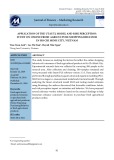

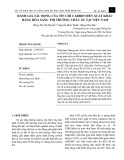
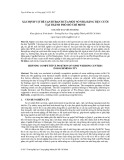
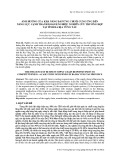
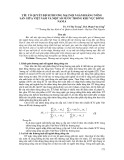
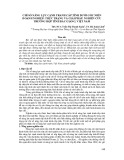
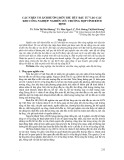
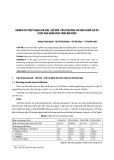
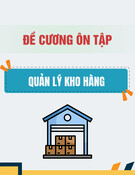
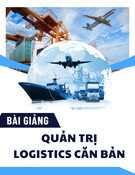
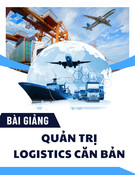
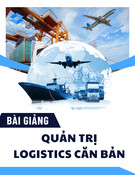
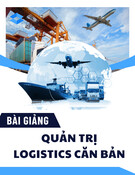
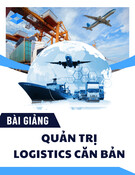

![Đề kiểm tra Quản trị logistics [mới nhất]](https://cdn.tailieu.vn/images/document/thumbnail/2025/20251015/2221002303@sv.ufm.edu.vn/135x160/35151760580355.jpg)
![Bộ câu hỏi thi vấn đáp Quản trị Logistics [năm hiện tại]](https://cdn.tailieu.vn/images/document/thumbnail/2025/20251014/baopn2005@gmail.com/135x160/40361760495274.jpg)
